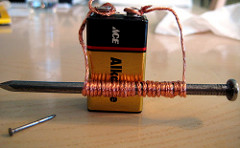Electricity and Magnetism Study Guide (8th Grade)
Unlock all answers in this set
Unlock answersquestion
Charge
answer
A physical property resulting from the collection of, or dispersion, of electrons.
question
Static Electricity
answer
A buildup of charges on an object. Generally produced by friction or induction.
question
Charge via Friction
answer
As two objects rub together, electrons from one object are transferred from one to the other.
question
Induction
answer
Description: A negative(ly) charged object - when placed near a neutral object - causes the electrons on another object to be repelled, leaving a positively charged surface because only the electrons can move - the protons are locked in place by the nucleus.
question
Conduction
answer
Description: A negatively charged object (like a plastic ruler) transfers some of its electrons to a neutral object when they touch.
question
Electricity
answer
A form of energy caused by the movement of electrons. The flow of electrons.
question
Direct Current
answer
Direct current (known as DC) is a current that flows through a conductor in one direction only.
question
Direct Current Examples
answer
Battery powered laptops, cellphones or flashlights.
question
Alternating Current
answer
Alternating Current (known as AC) and is a flow of electric charge that regularly reverses directions.
question
Alternating Current Examples
answer
In anything used in your home or on the main power grid from the electric company: TV, vacuum cleaner, microwave.
question
Voltage
answer
The potential difference measured in volts, and the amount of work to be done to move a charge from one point to another. The \"V\" in V=IR
question
Current
answer
A movement of electrical charges around a closed path or circuit, measured in amperes (amps, A), the I in V=IR
question
Resistance
answer
A material's opposition to the flow of electric current. The R in V=IR
question
V=IR
answer
The relationship between voltage, resistance and current. Voltage is equal to current times resistance (V=IR).
question
Series Circuit Advantages
answer
It uses less wire and energy so your batteries will last longer.
question
Series Circuit Disadvantages
answer
The current is shared, so each resistor gets less energy (i.e, each light bulb will be dimmer) and if one bulb breaks all others will stop working as well.
question
Diagram: Series Circuit

answer
With Battery, Switch, and 3 Resistors
question
Parallel Circuit Advantages
answer
The resistors each get the full benefit of the charge (i.e., lights will be brighter), and if one break all others continue to function.
question
Parallel Circuit Disadvantages
answer
They require more energy so your battery won't last as long, they use more wire as each resistor requires its own path.
question
Diagram: Parallel Circuit

answer
With Battery, Switch, and 3 resistors.
question
Magnet
answer
Any material that attracts iron or items that contain iron.
question
Permanent Magnet
answer
A material that will retain its magnetism for a long time. Its domains will remain aligned (i.e., cobalt, nickel, iron).
question
Electromagnet

answer
A coil wrapped around an iron core that acts as a magnet when an electric current flows through the wire coil.
question
Electromagnet Advantages
answer
Electromagnets can be turned on and off.
question
Simple Motor Operation
answer
A current turns off and on, causing a magnet to spin.
question
Magnetic Field Effects (on a Compass)
answer
The direction of a needle will change due to the magnetic field.
question
Conductive Solutions
answer
Solutions that contain ions (electrolytes) that allow for the transfer of electrons (an electric current).
question
Law of Electric Charges
answer
Opposite charges attract while like charges repel.
question
Insulator
answer
A material that resists the flow of electrons.
question
Conductor
answer
A material through which electrons can easily flow.
question
Ohm's Law Calculation
answer
V=IR, i.e., the voltage needed to make a current of 5A in a resistance of 15ohms is: V=5A x 15ohms =75v
question
Current in Amperes
answer
V=IR, so I=V/R
question
Poles
answer
The opposite ends of a magnet.
question
Magnetic Force
answer
The push or pull that magnets exert on each other.
question
Domains of an Atom for Magnetism
answer
The domains of an atom must all be aligned (going in the same direction) in order to be magnetic.
question
Results of a Cut Bar Magnet
answer
It forms two smaller magnets, each with a north and south pole.



